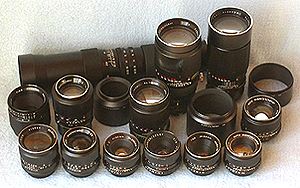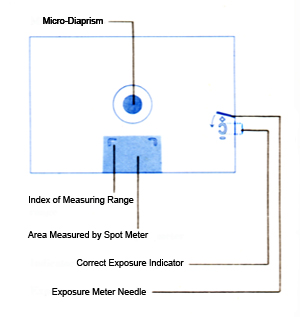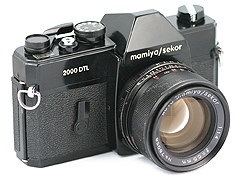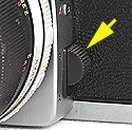|

Mamiya/Sekor 500TL (c.1966) R. Herron Collection

Mamiya/Sekor 1000TL (c.1966) R. Herron Collection
To view the Mamiya lenses available
for the TL & DTL,
Click Here!
Historic Note
Beginning in 1967, all Japanese cameras made for export were required to undergo
significant intensive testing, designed to assure they would prove to be
trouble-free under normal use. The government body known as the Japan Camera and
Optical Instruments Inspection and Testing Institute (JCII) was responsible.
Lens Adapters Available for Digital!
Lens adapters are available allowing the many of Mamiya's
threaded lenses (M42) to be used on the new Canon EOS digital SLR's!
These adapters (and adapters for other DSLR brands) can often be found
on eBay. Used in conjunction with original Mamiya P-adapters, they
also allow use of Mamiya CS and E bayonet-mount lenses.
|
Mamiya/Sekor TL Series
The Mamiya/Sekor 500TL and 1000TL
cameras were introduced in October 1966. Fully mechanical, they
came with a wide variety of interchangeable lenses (all designated
as "Auto Mamiya/Sekor").
The lens mount was the same 42mm threaded
mount developed for the Praktica and popularized by Pentax. The
TL-series was the first Mamiya 35mm with CdS through-the-lens (TTL)
metering. It was powered by one MS-76 or equivalent 1.5v battery,
and provided a spot meter that measured approximately 10% of the viewfinder
area.

Mamiya M42 lens series (photo
courtesy R. Stauber, Germany)

With a horizontal, mechanical focal-plane shutter
with cloth curtains, it has an ASA range from 25 to 800, with shutter
speeds from 1 sec. to 1/500 (1/1000 on the 1000TL), with a Bulb
setting. The flash would synch at 1/60 and both cameras originally
came with an optional flash mount (cold) that attached over the
prism housing via the rear finder (it is visible in the 500TL picture
above). The 1000TL model added a self-timer.
Like many Mamiya 35mm cameras, the TL series was also sold with rebranded
names, particularly in Germany, where the retailing powerhouse Porst
(Porst went out of business in the 1980s) demanded house-brand cameras that
could be sold for less than the "original" brand name! The Mamiya 500- and
1000-TL cameras were sold as the Porst Reflex 500c and the Porst
Superflex 1000c, respectively.
Note: Information on MAMIYA/SEKOR 528TL or 528AL cameras can be
found on the
Fixed Lens SLR page.
|
|

Mamiya/Sekor 1000DTL (c.1968) R.
Herron Collection

Mamiya/Sekor 500DTL (c.1968) R.
Herron Collection

Black Mamiya/Sekor 1000DTL (c.1968)
R. Herron Collection

Mamiya/Sekor 2000DTL (c.1969) R.
Herron Collection
A black-bodied version of the 1000 DTL was
offered in a limited quantity. Mamiya also introduced a black-bodied
2000 DTL (with a faster 1/2000 shutter speed) in 1969.
There is some information available indicating it was first shown
at the 1966 Photokina, but production models were not sold until
1969. It was intended primarily for export. An extremely fast shutter-speed
option for the era, it did not endure long and is a very rare camera
today.
|
Mamiya/Sekor DTL Series
The Mamiya 500- and 1000-DTL series cameras
were introduced in July 1968. Along with the TL series, these Mamiya/Sekor
cameras were the popular backbone of the Mamiya line in the mid-to-late
60s. They were sturdily built, with excellent optics. The DTL lenses
were virtually identical to those on the TL-series. They still used
the universal "Pentax type" 42mm screw-on mount, although later
DTL lenses are identified by the black lens ring which replaced
the earlier chrome version. Either lens ring can be found on each
series of these cameras today.
The major difference in the newer DTL series was the addition
of dual metering patterns, where both spot meter (10 percent of the field)
and average readings were possible. The DTL's are also capable of
measuring over a wider ASA range (25-3200), and the 1000-series
again provided a self-timer that was not included on the 500 DTL.
The Mamiya 500- and 1000-DTL were the only cameras
of their day to offer these dual metering patterns! This metering
feature, which would eventually become an important marketing feature
for all cameras, did not become generally available on SLR's from
other manufacturers for several years after the Mamiya 500- and
1000-DTL.
An "A" and "S" switch, near the lens mount on the DTL camera body,
is used to choose between the average- and spot-meter utility. The
light meter itself is activated by pulling the film advance lever
slightly away from the camera body. Readings are taken by pushing
the lever back toward the body and reading the result through the
viewfinder. The meter is designed to be entirely deactivated by
depressing the round button on top of the film advance lever.

DTL Average/Spot Meter Switch

A schematic of the DTL, showing the
relationship of its metering components.
An extremely sturdy camera, both the TL- and the
DTL-series are still widely available. They are often sold as "a
completely mechanical camera, great for students" at reasonable
prices.
Although they now often require repair to the light meter,
if the lenses are clean it is an extremely worthwhile investment
to buy and fix for everyday shooting, even without the meter. The
entire TL/DTL series uses one MS-76 or equivalent 1.5v battery,
still readily available.
|